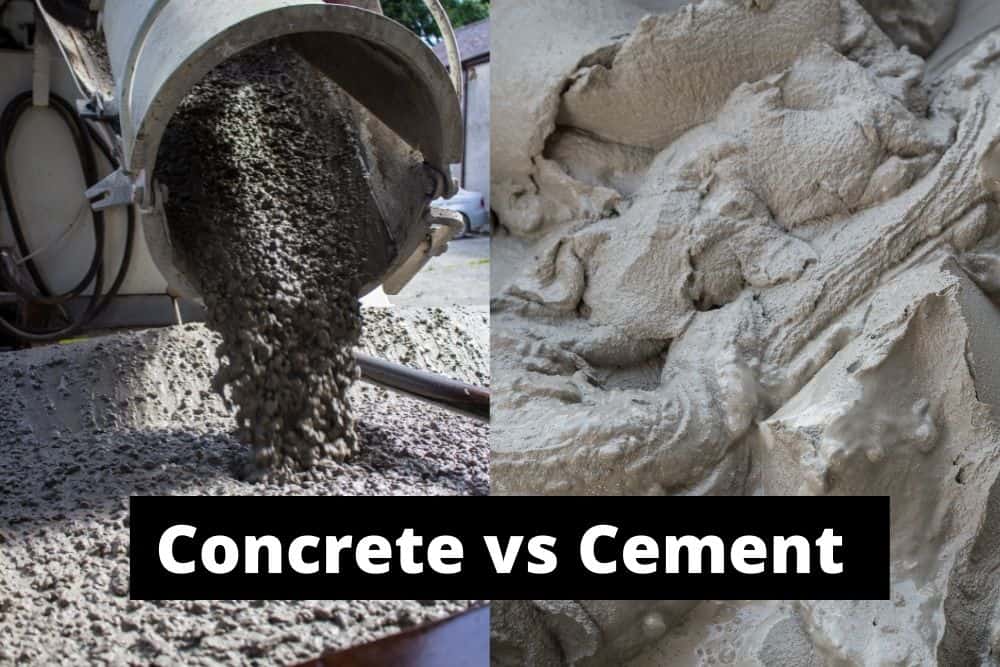Difference between Concrete & Cement
Cement Defined
Cement is one of the most commonly used construction materials. Cement works as a binding compound for sticking various construction materials together.
There’re several brands of cement available today. Some brands contain extra ingredients that make them more special than others.

Cement is available as a dry powder or a paste (mortar). The powder form of cement is mixed with water when making a cement mixture.
On the other hand, the paste form of cement is readily mixed and hardens upon application on an appropriate surface.
Some of the ingredients found in premium cement brands include bauxite, clay or sand, iron ore, and limestone.
Other extra ingredients may include slag, chalk, slate, shells, marl, and shale. These ingredients are mixed in a cement processing plant.
Once mixed, they’re heated to form clinker, which is a hard substance.
Thereafter, the hard clinker is ground to form a powder, which is known as cement. The cement powder is mixed with an appropriate amount of water in readiness for application.
Concrete Defined
Concrete refers to a durable construction material that comprises cement as a key ingredient. The main ingredients found in concrete include cement, sand, stone, and water.
When mixing these ingredients, you’ll get a stronger mixture by adding less water. However, adding more water forms a weaker mixture.
Essentially, water activates cement in the concrete mixture, thereby binding the ingredients to form a solid block. It’s cement that binds the aggregates in the concrete mixture together.
Concrete mixes prepared using larger aggregates are often stronger than mixes prepared using finer aggregates.
What are the Qualities of a Good Concrete Mixture?
Good concrete has certain qualities that make it different from poor concrete. For instance, the mix should be workable for easy pouring and consolidation.
Although less water forms a strong concrete mix, if the mix is very dry, you’ll find it hard to pour it.
Also, there’re certain specifications that have to be met once the concrete hardens. A good concrete mix should resist deicing chemicals, thawing, and freezing.
Also, it should be strong, watertight, and wear-resistant. Besides these requirements, it’s essential to ensure the mixture is created using the best concrete mix design.
What is Concrete Mix Design?
Essentially, concrete mix design refers to the process used in creating an optimized concrete mix.
There’re five components that should be considered by concrete workers when coming up with an appropriate mix design. These considerations include:
- Strength- It’s an important consideration as it determines the structural strength of the mix in withstanding a load.
- Density- The density of the mix contributes to its durability and strength.
- Durability- It determines the longevity of the concrete mix.
- Appearance- There’s a need to consider the appearance of the mix, especially when used in decorative applications.
- Workability- It refers to the ease of pouring or pumping concrete into place.
Building a Structure with Concrete
Concrete is one of the most commonly used building materials, thanks to its superb strength and durability.
Concrete is used in several building applications including drainage culverts running beneath the streets, sidewalks, driveways, and skyscrapers among others.
Due it is versatility, you can pour concrete effortlessly to form the desired shape. Thus, you’ll not have to weld, cut, shape, or bend the installation pieces as you can easily shape them with concrete.
Most architects prefer concrete due to its great energy efficiency. Also, it adds safety to the space it surrounds.
Wood Frames vs Insulated Concrete Forms
Several years ago, most homes were built using wood frames. Today, most architects prefer building homes with insulated concrete forms (ICFs) instead of wood.
There’re several reasons behind this preference. For instance, wood is susceptible to rot, moisture damage, fire, termites, and other kinds of damage. Consequently, architects turned to ICFs as they’re less susceptible to such damages.
ICFs comprise large blocks built with a material that resembles Styrofoam. The blocks feature channels that are cut through the middle like cinderblocks.
The blocks are designed for easier stacking on top of each other. Builders make a wall by stacking the blocks together.
Next, the builders drive reinforcing bars through the channels. Next, they pour concrete into the channels until full.
Houses built with ICFs are durable and well insulated. Also, they’re waterproof and enhance soundproofing.
They’re very popular in areas where hurricanes pose threats to structures such that builders have to build strong and durable houses.
Final Thoughts
While some people use the terms cement and concrete interchangeably, there’s a clear difference between concrete & cement.
Cement is just one of the main components used in preparing concrete while concrete refers to a construction material used in making solid structures.
Knowing their difference will assist you to understand the key construction materials used around you.
Related:
